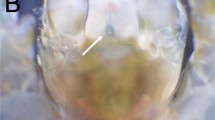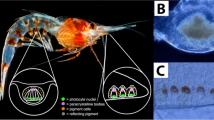Abstract
Photoreceptor structure and function in the Platyhelminthes has traditionally been treated separately in the Turbellaria on one hand and the conventional parasitic classes on the other. In this paper, an attempt is made to bring together data from the literature and to highlight deficiencies and areas where a more integrated approach would be beneficial. This is done with particular reference to the endosymbiont genus Paravortex which belongs to the Turbellaria but which functionally has more similarities to the parasitic platyhelminths especially with regard to the host-finding requirement of the larval stages.
Similar content being viewed by others
References
Brooker, B. E., 1972. The sense organs of trematode miracidia. In E. U. Canning & C. A. Wright (eds), Behavioural aspects of parasite transmission. Zool. J. linn. Soc. 51 suppl.: 171–180.
Bedini, C., E. Ferrero & A. Lanfranchi, 1977. Fine structural changes induced by circadian light-dark cycles in photoreceptors of Dalyellidae (Turbellaria: Rhabdocoela). J. ultrastruct. Res. 58: 66–77.
Calow, P. & J. B. Jennings, 1974. Calorific values in the phylum Platyhelminthes: the relationship between potential energy, mode of life and the evolution of entoparasitism. Biol. Bull. 147: 81–94.
Carpenter, K. S., M. Morita & J. B. Best, 1974. Ultrastructure of the photoreceptor of the planarian Dugesia dorotocephala. II. Changes induced by darkness and light. Cytobiologie 8: 320–338.
Eakin, R. M. & J. L. Brandenburger, 1981. Fine structure of the eyes of Pseudoceros canadensis (Turbellaria, Polycladida). Zoomorphologie 98: 1–16.
Ehlers, B. & U. Ehlers, 1977a. Die Feinstruktur eines ciliaren Lamellarkörpers bei Parotoplanina geminoducta Ax (Turbellarian, Proseriata). Zoomorphologie 87: 65–72.
Ehlers, B. & U. Ehlers, 1977b. Ultrastruktur perecerebraler Cilienaggregate bei Dicoelandropora atriopapillata Ax and Notocaryoplanella glandulosa Ax (Turbellaria, Proseriata). Zoomorphologie 88: 163–174.
Erasmus, D. A., 1972. The biology of trematodes. Arnold, London, 312 pp.
Fournier, A., 1975. Les taches pigmentaires de l'oncomiracidium d'Euzetrema knoepffleri (Monogenea): ultrastructure et évolution au cours du cycle biologique. Z. Parasitkde 46: 203–209.
Fournier, A. & C. Combes, 1978. Structure of photoreceptors of Polystoma integerrimum (Platyhelminthes, Monogenea). Zoomorphologie 91: 147–155.
Hyman, L. H., 1951. The Invertebrates: Platyhelminthes and Rhynchocoela. The acoelomate bilateria. Vol. II. McGraw-Hill, N.Y., 550 pp.
Isseroff, H. & R. M. Cable, 1968. Fine structure of photoreceptors in larval trematodes. Z. Zellforsch. 86: 511–534.
Jennings, J. B., 1974. Symbiosis in the Turbellaria and their implications in studies on the evolution of entoparasitism. In W. B. Vernberg (ed), Symbiosis in the Sea. University of South Carolina Press: 127–160.
Jennings, J. B. & P. Calow, 1975. The relationship between high fecundity and the evolution of entoparasitism. Oecologia 21: 109–115.
Jennings, J. B. & W. B. LeFlore, 1979. Occurrence and possible adaptive significance of some histochemically demonstrable dehydrogenases in two entosymbiotic rhabdocoels (Platyhelminthes: Turbellaria). Comp. Biochem. Physiol. 62B: 301–304.
Jennings, J. B. & J. I. Phillips, 1978. Feeding and digestion in three entosymbiotic graffillid rhabdocoels from bivalve and gastropod molluscs. Biol. Bull. 155: 542–562.
Kearn, G. G., 1971. The attachment site, invasion route and larval development of Trochopus pini, a monogenean from the gills of Trigla hirundo. Parasitology 63: 513–525.
Kearn, G. C., 1973. An endogenous circadian hatching rhythm in the monogenean skin parasite, Entobdella soleae, and its relationship to the activity rhythm of the host (Solea solea). Parasitology 66: 101–122.
Kearn, G. G., 1978. Eyes with, and without, pigment shields in the oncomiracidium of the monogenean parasite Diplozoon paradoxum. Z. Parasitkde 57: 35–47.
Kearn, G. G., 1980. Light and gravity responses of the oncomiracidium of Entobdella soleae and their role in host location. Parasitology 81: 71–89.
Lanfranchi, A. & C. Bedini, 1982. The ultrastructure of the sense organs of some Turbellaria Rhabdocoella: 1. The eyes of Polycystis naeglii (Eukalyptorhynchia, Polycystididae). Zoomorphologie 101: 95–102.
Lanfranchi, A., C. Bedini & E. Ferrero, 1981. The ultrastructure of the eyes in larval and adult polyclads (Turbellaria). Hydrobiologia 84: 267–275.
Llewellyn, J., 1963. Larvae and larval development of monogeneans. Advances in Parasitology 1: 287–326.
Llewellyn, J., 1972. Behaviour of monogeneans. In E. U. Canning & C. A. Wright (eds), Behavioural aspects of parasite transmission. Zool. J. Linn. Soc. 51 suppl.: 19–30.
Lyons, K. M., 1972. Sense organs of monogeneans. In E. U. Canning & C. A. Wright (eds), Behavioural aspects of parasite transmission. Zool. J. linn. Soc. 51 suppl.: 181–199.
Pike, A. W. & M. D. B. Burt, 1981. Paravortex karlingi sp. nov. from Cerastoderma edule L., in Britain. Hydrobiologia 84: 23–30.
Röhlich, P. & E. Tar, 1968. The effect of prolonged light deprivation on the fine structure of planarian photoreceptors. Z. Zellforsch. mikrosk. Anat. 90: 507–518.
Röhlich, P. & J. Török, 1962. The effect of light and darkness on the fine structure of the retinal clubs of Dendrocoelum lacteum. Q. J. microsc. Sci. 104: 543–548.
Short, R. B. & H. T. Gagné, 1975. Fine structure of a possible photoreceptor in cercariae of Schistosoma mansoni. J. Parasitol. 61: 69–74.
Smyth, J. D. & D. H. Halton, 1983. Physiology of Trematodes 2nd Ed. Cambridge University Press.
Sopott-Ehlers, B., 1982. Ultrastructure of potential photoreceptor cells of a different organization in a proseriate (Platyhelminthes). Zoomorphologie 101: 165–176.
Xylander, W. E. R., 1984. A presumptive ciliary photoreceptor in larval Gyrocotyle urna Grube and Wagener (Cestoda). Zoomorphology 104: 21–25.
Whitfield, P. J. & J. Wells, 1973. Observations on the ectoparasitic digenean Transversotrema patialensis. Parasitology 67: xxvii-xxviii.
Author information
Authors and Affiliations
Rights and permissions
About this article
Cite this article
Pike, A.W., Wink, R. Aspects of photoreceptor structure and phototactic behavior in Platyhelminthes, with particular reference to the symbiotic turbellarian Paravortex . Hydrobiologia 132, 101–104 (1986). https://doi.org/10.1007/BF00046235
Issue Date:
DOI: https://doi.org/10.1007/BF00046235




